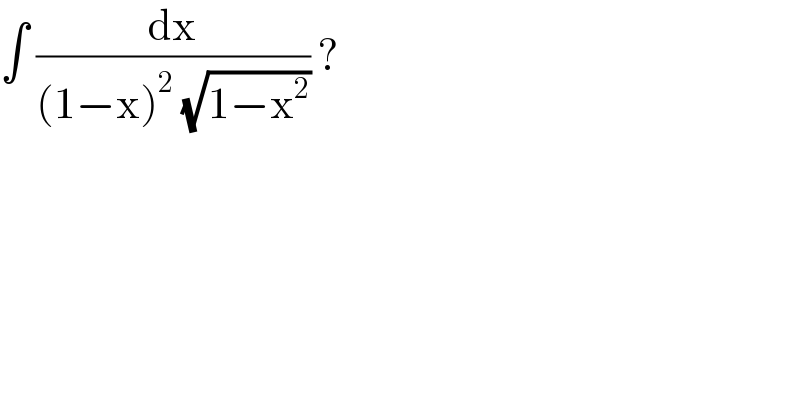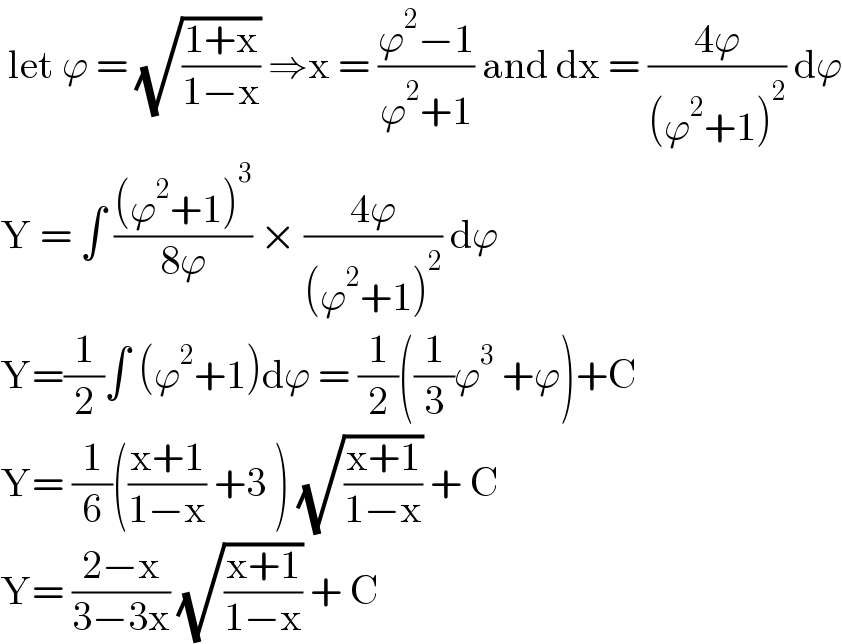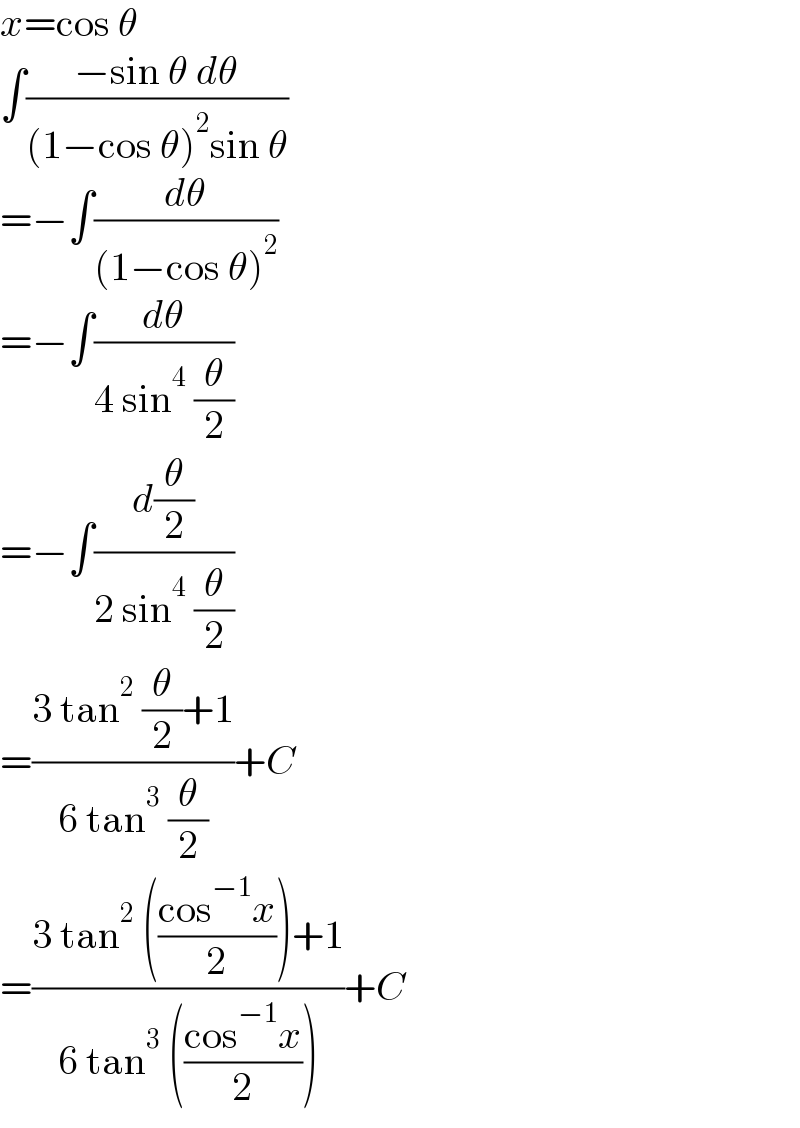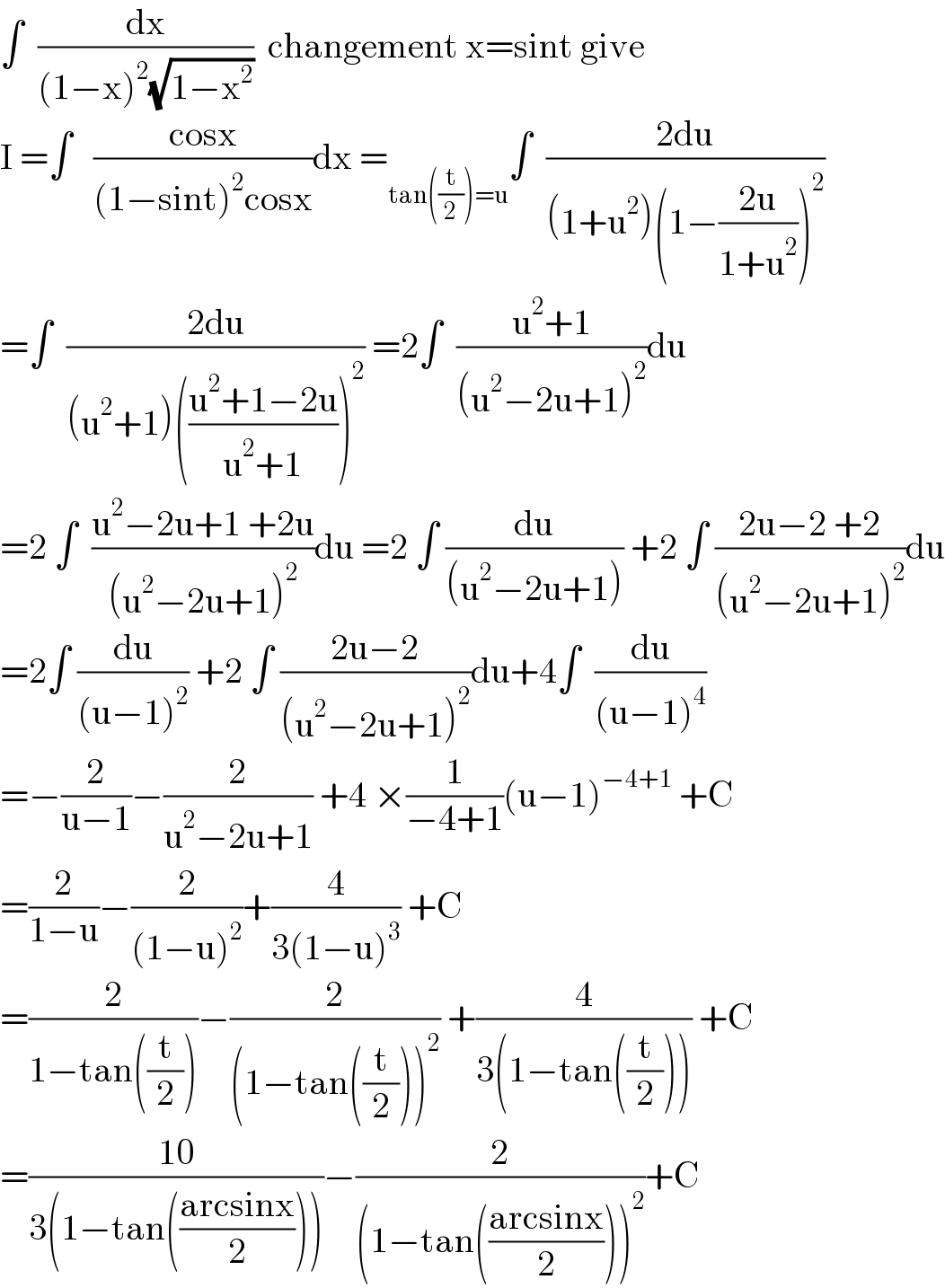Question Number 128775 by bramlexs22 last updated on 10/Jan/21

$$\int\:\frac{\mathrm{dx}}{\left(\mathrm{1}−\mathrm{x}\right)^{\mathrm{2}} \:\sqrt{\mathrm{1}−\mathrm{x}^{\mathrm{2}} }}\:? \\ $$
Answered by liberty last updated on 10/Jan/21

$$\:\mathrm{let}\:\varphi\:=\:\sqrt{\frac{\mathrm{1}+\mathrm{x}}{\mathrm{1}−\mathrm{x}}}\:\Rightarrow\mathrm{x}\:=\:\frac{\varphi^{\mathrm{2}} −\mathrm{1}}{\varphi^{\mathrm{2}} +\mathrm{1}}\:\mathrm{and}\:\mathrm{dx}\:=\:\frac{\mathrm{4}\varphi}{\left(\varphi^{\mathrm{2}} +\mathrm{1}\right)^{\mathrm{2}} }\:\mathrm{d}\varphi \\ $$$$\mathrm{Y}\:=\:\int\:\frac{\left(\varphi^{\mathrm{2}} +\mathrm{1}\right)^{\mathrm{3}} }{\mathrm{8}\varphi}\:×\:\frac{\mathrm{4}\varphi}{\left(\varphi^{\mathrm{2}} +\mathrm{1}\right)^{\mathrm{2}} }\:\mathrm{d}\varphi \\ $$$$\mathrm{Y}=\frac{\mathrm{1}}{\mathrm{2}}\int\:\left(\varphi^{\mathrm{2}} +\mathrm{1}\right)\mathrm{d}\varphi\:=\:\frac{\mathrm{1}}{\mathrm{2}}\left(\frac{\mathrm{1}}{\mathrm{3}}\varphi^{\mathrm{3}} \:+\varphi\right)+\mathrm{C} \\ $$$$\mathrm{Y}=\:\frac{\mathrm{1}}{\mathrm{6}}\left(\frac{\mathrm{x}+\mathrm{1}}{\mathrm{1}−\mathrm{x}}\:+\mathrm{3}\:\right)\:\sqrt{\frac{\mathrm{x}+\mathrm{1}}{\mathrm{1}−\mathrm{x}}}\:+\:\mathrm{C} \\ $$$$\mathrm{Y}=\:\frac{\mathrm{2}−\mathrm{x}}{\mathrm{3}−\mathrm{3x}}\:\sqrt{\frac{\mathrm{x}+\mathrm{1}}{\mathrm{1}−\mathrm{x}}}\:+\:\mathrm{C}\: \\ $$
Answered by mr W last updated on 10/Jan/21

$${x}=\mathrm{cos}\:\theta \\ $$$$\int\frac{−\mathrm{sin}\:\theta\:{d}\theta}{\left(\mathrm{1}−\mathrm{cos}\:\theta\right)^{\mathrm{2}} \mathrm{sin}\:\theta} \\ $$$$=−\int\frac{{d}\theta}{\left(\mathrm{1}−\mathrm{cos}\:\theta\right)^{\mathrm{2}} } \\ $$$$=−\int\frac{{d}\theta}{\mathrm{4}\:\mathrm{sin}^{\mathrm{4}} \:\frac{\theta}{\mathrm{2}}} \\ $$$$=−\int\frac{{d}\frac{\theta}{\mathrm{2}}}{\mathrm{2}\:\mathrm{sin}^{\mathrm{4}} \:\frac{\theta}{\mathrm{2}}} \\ $$$$=\frac{\mathrm{3}\:\mathrm{tan}^{\mathrm{2}} \:\frac{\theta}{\mathrm{2}}+\mathrm{1}}{\mathrm{6}\:\mathrm{tan}^{\mathrm{3}} \:\frac{\theta}{\mathrm{2}}}+{C} \\ $$$$=\frac{\mathrm{3}\:\mathrm{tan}^{\mathrm{2}} \:\left(\frac{\mathrm{cos}^{−\mathrm{1}} {x}}{\mathrm{2}}\right)+\mathrm{1}}{\mathrm{6}\:\mathrm{tan}^{\mathrm{3}} \:\left(\frac{\mathrm{cos}^{−\mathrm{1}} {x}}{\mathrm{2}}\right)}+{C} \\ $$
Answered by mathmax by abdo last updated on 10/Jan/21

$$\int\:\:\frac{\mathrm{dx}}{\left(\mathrm{1}−\mathrm{x}\right)^{\mathrm{2}} \sqrt{\mathrm{1}−\mathrm{x}^{\mathrm{2}} }}\:\:\mathrm{changement}\:\mathrm{x}=\mathrm{sint}\:\mathrm{give} \\ $$$$\mathrm{I}\:=\int\:\:\:\frac{\mathrm{cosx}}{\left(\mathrm{1}−\mathrm{sint}\right)^{\mathrm{2}} \mathrm{cosx}}\mathrm{dx}\:=_{\mathrm{tan}\left(\frac{\mathrm{t}}{\mathrm{2}}\right)=\mathrm{u}} \int\:\:\frac{\mathrm{2du}}{\left(\mathrm{1}+\mathrm{u}^{\mathrm{2}} \right)\left(\mathrm{1}−\frac{\mathrm{2u}}{\mathrm{1}+\mathrm{u}^{\mathrm{2}} }\right)^{\mathrm{2}} } \\ $$$$=\int\:\:\frac{\mathrm{2du}}{\left(\mathrm{u}^{\mathrm{2}} +\mathrm{1}\right)\left(\frac{\mathrm{u}^{\mathrm{2}} +\mathrm{1}−\mathrm{2u}}{\mathrm{u}^{\mathrm{2}} +\mathrm{1}}\right)^{\mathrm{2}} }\:=\mathrm{2}\int\:\:\frac{\mathrm{u}^{\mathrm{2}} +\mathrm{1}}{\left(\mathrm{u}^{\mathrm{2}} −\mathrm{2u}+\mathrm{1}\right)^{\mathrm{2}} }\mathrm{du} \\ $$$$=\mathrm{2}\:\int\:\:\frac{\mathrm{u}^{\mathrm{2}} −\mathrm{2u}+\mathrm{1}\:+\mathrm{2u}}{\left(\mathrm{u}^{\mathrm{2}} −\mathrm{2u}+\mathrm{1}\right)^{\mathrm{2}} }\mathrm{du}\:=\mathrm{2}\:\int\:\frac{\mathrm{du}}{\left(\mathrm{u}^{\mathrm{2}} −\mathrm{2u}+\mathrm{1}\right)}\:+\mathrm{2}\:\int\:\frac{\mathrm{2u}−\mathrm{2}\:+\mathrm{2}}{\left(\mathrm{u}^{\mathrm{2}} −\mathrm{2u}+\mathrm{1}\right)^{\mathrm{2}} }\mathrm{du} \\ $$$$=\mathrm{2}\int\:\frac{\mathrm{du}}{\left(\mathrm{u}−\mathrm{1}\right)^{\mathrm{2}} }\:+\mathrm{2}\:\int\:\frac{\mathrm{2u}−\mathrm{2}}{\left(\mathrm{u}^{\mathrm{2}} −\mathrm{2u}+\mathrm{1}\right)^{\mathrm{2}} }\mathrm{du}+\mathrm{4}\int\:\:\frac{\mathrm{du}}{\left(\mathrm{u}−\mathrm{1}\right)^{\mathrm{4}} } \\ $$$$=−\frac{\mathrm{2}}{\mathrm{u}−\mathrm{1}}−\frac{\mathrm{2}}{\mathrm{u}^{\mathrm{2}} −\mathrm{2u}+\mathrm{1}}\:+\mathrm{4}\:×\frac{\mathrm{1}}{−\mathrm{4}+\mathrm{1}}\left(\mathrm{u}−\mathrm{1}\right)^{−\mathrm{4}+\mathrm{1}} \:+\mathrm{C} \\ $$$$=\frac{\mathrm{2}}{\mathrm{1}−\mathrm{u}}−\frac{\mathrm{2}}{\left(\mathrm{1}−\mathrm{u}\right)^{\mathrm{2}} }+\frac{\mathrm{4}}{\mathrm{3}\left(\mathrm{1}−\mathrm{u}\right)^{\mathrm{3}} }\:+\mathrm{C} \\ $$$$=\frac{\mathrm{2}}{\mathrm{1}−\mathrm{tan}\left(\frac{\mathrm{t}}{\mathrm{2}}\right)}−\frac{\mathrm{2}}{\left(\mathrm{1}−\mathrm{tan}\left(\frac{\mathrm{t}}{\mathrm{2}}\right)\right)^{\mathrm{2}} }\:+\frac{\mathrm{4}}{\mathrm{3}\left(\mathrm{1}−\mathrm{tan}\left(\frac{\mathrm{t}}{\mathrm{2}}\right)\right)}\:+\mathrm{C} \\ $$$$=\frac{\mathrm{10}}{\mathrm{3}\left(\mathrm{1}−\mathrm{tan}\left(\frac{\mathrm{arcsinx}}{\mathrm{2}}\right)\right)}−\frac{\mathrm{2}}{\left(\mathrm{1}−\mathrm{tan}\left(\frac{\mathrm{arcsinx}}{\mathrm{2}}\right)\right)^{\mathrm{2}} }+\mathrm{C} \\ $$
